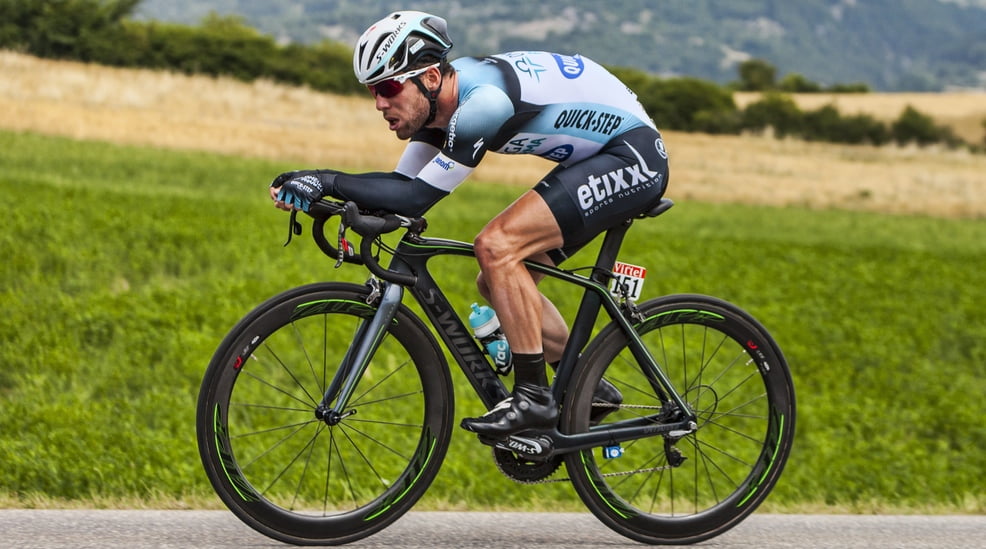For cycling enthusiasts, it was wonderful to have the Tour de France start in Yorkshire this month. But it was a keen disappointment to see Mark Cavendish crash near the end of the opening stage. Mark dislocated his right shoulder and is out of this year’s race. Although we do not know exactly what injuries he has, there are a couple of Cochrane reviewsCochrane Reviews are systematic reviews. In systematic reviews we search for and summarize studies that answer a specific research question (e.g. is paracetamol effective and safe for treating back pain?). The studies are identified, assessed, and summarized by using a systematic and predefined approach. They inform recommendations for healthcare and research. on the treatmentSomething done with the aim of improving health or relieving suffering. For example, medicines, surgery, psychological and physical therapies, diet and exercise changes. of anterior shoulder dislocation, which is the most common type of this sort of injury.
Anterior shoulder dislocation is where the top end of the upper arm bone is pushed out of the joint socket in a forward direction. These injuries can be treated non-surgically or surgically. The aim of all treatment is to restore a fully functioning, painless, and stable shoulder. But this may not be possible as the joint damage from a dislocation often makes the shoulder less stable. Active young adults, such as Mark, are particularly at riskA way of expressing the chance of an event taking place, expressed as the number of events divided by the total number of observations or people. It can be stated as ‘the chance of falling were one in four’ (1/4 = 25%). This measure is good no matter the incidence of events i.e. common or infrequent. of a re-dislocation.
What does non-surgical treatment involve?
In the absence of other major injuries such as a fracture, initial treatment involves putting the joint back in place. This is ‘closed reduction’, where the joint is manipulated back into place without surgery. This is followed by a short period (3 to 6 weeks) of immobilisation, which involves placement of the injured arm in a sling or in another immobilising device, and then physical therapy.
What is the best position of the arm during immobilisation?

Credit: chris2766, shutterstock.com
The recently updated Cochrane review that looked at different non-surgical ways of managing these injuries after the joint had been put back into place addressed this question. It included evidence from four trialsClinical trials are research studies involving people who use healthcare services. They often compare a new or different treatment with the best treatment currently available. This is to test whether the new or different treatment is safe, effective and any better than what is currently used. No matter how promising a new treatment may appear during tests in a laboratory, it must go through clinical trials before its benefits and risks can really be known. involving 470 participants (371 male). All had first time traumatic anterior dislocation of the shoulder. The four trials compared immobilisation of the arm in external rotation (when the arm is orientated outwards with the forearm away from the chest) versus immobilisation in internal rotation (the usual sling position, where the arm rests against the chest). External rotation is an unnatural pose but is supposed to bring the joint tissues in a better position for healing. However, it is more awkward and a rigid device is needed to keep the arm in place. The evidence showed no difference in outcomeOutcomes are measures of health (for example quality of life, pain, blood sugar levels) that can be used to assess the effectiveness and safety of a treatment or other intervention (for example a drug, surgery, or exercise). In research, the outcomes considered most important are ‘primary outcomes’ and those considered less important are ‘secondary outcomes’., such as redislocation in ensuing two years, between the two methods. Thus, the review concludes that it is better to keep to the traditional position of internal rotation for the time being.
What does surgical treatment involve?
After closed reduction of the acuteA health condition (or episodes of a health condition) that comes on quickly and is short-lived. dislocation, surgical treatment typically involves repair of the damaged structures and/or cleaning up the joint space. Often ‘key hole’ (arthroscopic) surgery is used but open surgery may be used, especially for more complex operations. Surgery is usually followed by a short period in a sling and physical therapy.
When is surgery better?
The Cochrane review asking this question included four trials involving 163 active young adult males, all with a first time traumatic anterior shoulder dislocation. It found that for this populationThe group of people being studied. Populations may be defined by any characteristics e.g. where they live, age group, certain diseases., surgery gave better results than non-surgical treatment. Participants who had been treated surgically had better shoulder stability with fewer having a redislocation. They also had better self-reported shoulder function. Although the evidence was limited, it supported the use of primary surgery for young males engaged in highly demanding physical activities. As Mark fits this category, and moreover was reported subsequently to have several torn ligaments, it is not surprising that he was informed that he must have surgery.
Picture credit: Featured image CHORGES, FRANCE- JUL 17:The Manx cyclist Mark Cavendish pedaling during the stage 17 of 100th edition of Le Tour de France, a time trial between Embrun and Chorges on July 17 2013. Credit: Razvan / Shutterstock.com.
Links:
Hanchard NCA, Goodchild LM, Kottam L. Conservative management following closed reduction of traumatic anterior dislocation of the shoulder. Cochrane Database of Systematic ReviewsIn systematic reviews we search for and summarize studies that answer a specific research question (e.g. is paracetamol effective and safe for treating back pain?). The studies are identified, assessed, and summarized by using a systematic and predefined approach. They inform recommendations for healthcare and research. 2014, Issue 4. Art. No.: CD004962. DOI: 10.1002/14651858.CD004962.pub3.
Cochrane summaries http://summaries.cochrane.org/CD004962/non-surgical-management-after-non-surgical-repositioning-of-traumatic-anterior-dislocation-of-the-shoulder
Handoll HHG, Al-Maiyah MA. Surgical versus non-surgical treatment for acute anterior shoulder dislocation. Cochrane Database of Systematic Reviews 2004, Issue 1. Art. No.: CD004325. DOI:10.1002/14651858.CD004325.pub2.
Cochrane summary http://summaries.cochrane.org/CD004325/surgical-versus-non-surgical-treatment-for-acute-anterior-shoulder-dislocation
Handoll HHG, Hanchard NCA. From observation to evidence of effectivenessThe ability of an intervention (for example a drug, surgery, or exercise) to produce a desired effect, such as reduce symptoms.: the haphazard route to finding out if a new interventionA treatment, procedure or programme of health care that has the potential to change the course of events of a healthcare condition. Examples include a drug, surgery, exercise or counselling. works [editorial]. Cochrane Database of Systematic Reviews 2014;(5):ED000081: https://www.cochranelibrary.com/cdsr/doi/10.1002/14651858.ED000081/full)


